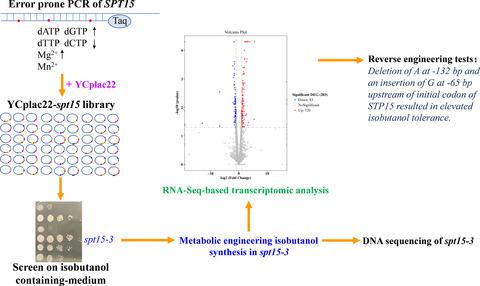当前位置:
X-MOL 学术
›
Lett. Appl. Microbiol.
›
论文详情
Our official English website, www.x-mol.net, welcomes your
feedback! (Note: you will need to create a separate account there.)
Isobutanol tolerance and production of Saccharomyces cerevisiae can be improved by engineering its TATA-binding protein Spt15
Letters in Applied Microbiology ( IF 2.0 ) Pub Date : 2021-08-21 , DOI: 10.1111/lam.13555 W Zhang 1 , W Shao 1 , A Zhang 1
Letters in Applied Microbiology ( IF 2.0 ) Pub Date : 2021-08-21 , DOI: 10.1111/lam.13555 W Zhang 1 , W Shao 1 , A Zhang 1
Affiliation

|
Low isobutanol tolerance of Saccharomyces cerevisiae limits its application in isobutanol fermentation. Here, we used global transcription machinery engineering to screen mutants with higher isobutanol tolerance and elevated isobutanol titres. TATA-binding protein Spt15 was used as the target of global transcription machinery engineering for improvement of such complex phenotypes. A random mutagenesis library of S. cerevisiae TATA-binding protein Spt15 was constructed and subjected to screening under isobutanol stress. A mutant strain (denoted as spt15-3) with improved isobutanol tolerance was identified. There were three mutations of Spt15 in strain spt15-3, including deletion of A at position −132 nt upstream of initiation codon, insertion of G at position −65 nt upstream of initiation codon and a synonymous mutation at position 315 nt (T → C) downstream of initiation codon. We then metabolically engineered isobutanol synthesis in strains harbouring plasmids YCplac22 containing these Spt15 mutations. Delta integration was used to overexpress ILV3 gene, and 2μ plasmids carrying PGK1p-ILV2 and PGK1p-ARO10 were used to overexpress ILV2 and ARO10 genes. After 24-h micro-aerobic fermentation, Engi-3 produced 0·556 g l−1 isobutanol, which was 404% and 25·3% greater than isobutanol produced by control Engi-1 and engineered Engi-2, respectively. After 28 h, Engi-4 produced 0·459 g l−1 isobutanol, which was 315% and 3·2% greater than isobutanol produced Engi-1 and Engi-2, respectively. RNA-Seq-based transcriptome analysis shows that mutations of Spt15 in strain spt15-3 increased the expression of SPT15. Meanwhile, compared with strain Engi-3, the spt15-3 mutation downregulated the expression of genes involved in the TCA cycle and glyoxylic acid cycle, but increased the expression of genes related to cell stability. This work demonstrates that isobutanol tolerance and production of S. cerevisiae can be improved by engineering its TATA-binding protein Spt15. This study clarified the molecular mechanisms regulating isobutanol production and tolerance in S. cerevisiae.
中文翻译:

通过改造其 TATA 结合蛋白 Spt15,可以提高酿酒酵母的异丁醇耐受性和产量
酿酒酵母对异丁醇的低耐受性限制了其在异丁醇发酵中的应用。在这里,我们使用全局转录机械工程来筛选具有更高异丁醇耐受性和更高异丁醇滴度的突变体。TATA 结合蛋白 Spt15 被用作全局转录机械工程的目标,以改善这种复杂的表型。构建了酿酒酵母TATA 结合蛋白 Spt15的随机诱变文库,并在异丁醇胁迫下进行筛选。鉴定了具有改进的异丁醇耐受性的突变菌株(表示为spt15 -3)。菌株spt15中有3个Spt15突变-3,包括起始密码子上游-132 nt位置的A缺失,起始密码子上游-65 nt位置的G插入以及起始密码子下游315 nt位置(T→C)的同义突变。然后,我们在携带含有这些 Spt15 突变的质粒 YCplac22 的菌株中代谢工程化异丁醇合成。三角洲一体化使用过表达ILV3基因,并携带2μ质粒PGK1p - ILV2和PGK1p-ARO10使用过表达ILV2和ARO10基因。24小时微需氧发酵后,Engi-3产生0·556 g l -1异丁醇,分别比对照 Engi-1 和工程化 Engi-2 生产的异丁醇高 404% 和 25·3%。28 小时后,Engi-4 产生0·459 g l -1异丁醇,分别比异丁醇产生的Engi-1 和Engi-2 多315% 和3·2%。基于 RNA-Seq 的转录组分析表明,菌株spt15 -3中 Spt15 的突变增加了SPT15的表达。同时,与菌株Engi-3相比,spt15-3突变下调TCA循环和乙醛酸循环相关基因的表达,但增加了与细胞稳定性相关的基因表达。这项工作证明了异丁醇耐受性和S 的产生。酿酒酵母可以通过改造其 TATA 结合蛋白 Spt15 来改进。该研究阐明了调节酿酒酵母中异丁醇产生和耐受性的分子机制。
更新日期:2021-08-21
中文翻译:

通过改造其 TATA 结合蛋白 Spt15,可以提高酿酒酵母的异丁醇耐受性和产量
酿酒酵母对异丁醇的低耐受性限制了其在异丁醇发酵中的应用。在这里,我们使用全局转录机械工程来筛选具有更高异丁醇耐受性和更高异丁醇滴度的突变体。TATA 结合蛋白 Spt15 被用作全局转录机械工程的目标,以改善这种复杂的表型。构建了酿酒酵母TATA 结合蛋白 Spt15的随机诱变文库,并在异丁醇胁迫下进行筛选。鉴定了具有改进的异丁醇耐受性的突变菌株(表示为spt15 -3)。菌株spt15中有3个Spt15突变-3,包括起始密码子上游-132 nt位置的A缺失,起始密码子上游-65 nt位置的G插入以及起始密码子下游315 nt位置(T→C)的同义突变。然后,我们在携带含有这些 Spt15 突变的质粒 YCplac22 的菌株中代谢工程化异丁醇合成。三角洲一体化使用过表达ILV3基因,并携带2μ质粒PGK1p - ILV2和PGK1p-ARO10使用过表达ILV2和ARO10基因。24小时微需氧发酵后,Engi-3产生0·556 g l -1异丁醇,分别比对照 Engi-1 和工程化 Engi-2 生产的异丁醇高 404% 和 25·3%。28 小时后,Engi-4 产生0·459 g l -1异丁醇,分别比异丁醇产生的Engi-1 和Engi-2 多315% 和3·2%。基于 RNA-Seq 的转录组分析表明,菌株spt15 -3中 Spt15 的突变增加了SPT15的表达。同时,与菌株Engi-3相比,spt15-3突变下调TCA循环和乙醛酸循环相关基因的表达,但增加了与细胞稳定性相关的基因表达。这项工作证明了异丁醇耐受性和S 的产生。酿酒酵母可以通过改造其 TATA 结合蛋白 Spt15 来改进。该研究阐明了调节酿酒酵母中异丁醇产生和耐受性的分子机制。











































 京公网安备 11010802027423号
京公网安备 11010802027423号